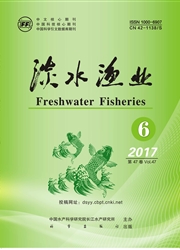

 中文摘要:
中文摘要:
于2010~2011年使用EY60回声探测仪对长江中游城陵矶至宜昌江段进行了6次水声学调查。通过设定分析水层以及选择性分析-55dB以上的目标,获得该江段大中型非底部鱼类的水声学分布特征。各年组中的平均密度以10月最低,2010年中7月最高,2011年中6月最高;年组间,2010年6月显著低于2011年6月,2010年7月与2011年7月、2010年10月与2011年10月两组差异不显著;鱼类纵向分布呈现独特的波动特征,不同时段的鱼类密度波动幅度、频率均有不同。各时段目标强度分布曲线10月相对6、7月更扁平,而且平均值大于6、7月;不同年组问目标强度差异均不显著;各月组问目标强度6月和7月对10月均表现极显著差异,6月对7月表现为显著差异。分析认为该结果的出现可能与鱼类的产卵、索饵及补充资源的临时分布等因素有关。
 英文摘要:
英文摘要:
A split-beam echosounder EY60 operating at 200 kHz was applied 6 times to estimate the density the fish stock in the middle reach of Yangtze River from Chenglingji to Yichang section in 2010 and 2011. We got the distribution of large or medium-sized non-bottom fishes in survey sections by setting the analysis layer and analyzing the targets selectivity of bigger than -55 dB. The average density of two year-groups showed that the lowest was in October, the highest of 2010 was in July, and the highest of 2011 was in June; in each year group, it was significantly lower in June 2010, than in June 2011, while the other two groups, July 2010 and July 2011, October 2010 and October 2011, were not significantly different ; the vertical distribution of fish showed the unique fluctuation characteristics in different periods, such as the different fluctuation range and frequencies of fish density. The TS distribution curves showed some differences in these sur-veys, it was more gentle in October than those in June and July, and also the average value in October was greater than in June and July ; the differences of TS distribution between different year-groups were not significant ( P 〉 0.05 ). T test for TS in month-groups showed highly significant differences in June vs. October and July vs. October (P 〈 0.01 ), and significant difference in June vs. July. The distribution was possibly caused by the reproductive migration, feeding migratory, temporary distribution of enhancement resources, and some other factors.
 同期刊论文项目
同期刊论文项目
 同项目期刊论文
同项目期刊论文
 Acoustic assessment of the fish spatio-temporal distribution during the initial filling of the Three
Acoustic assessment of the fish spatio-temporal distribution during the initial filling of the Three 期刊信息
期刊信息
